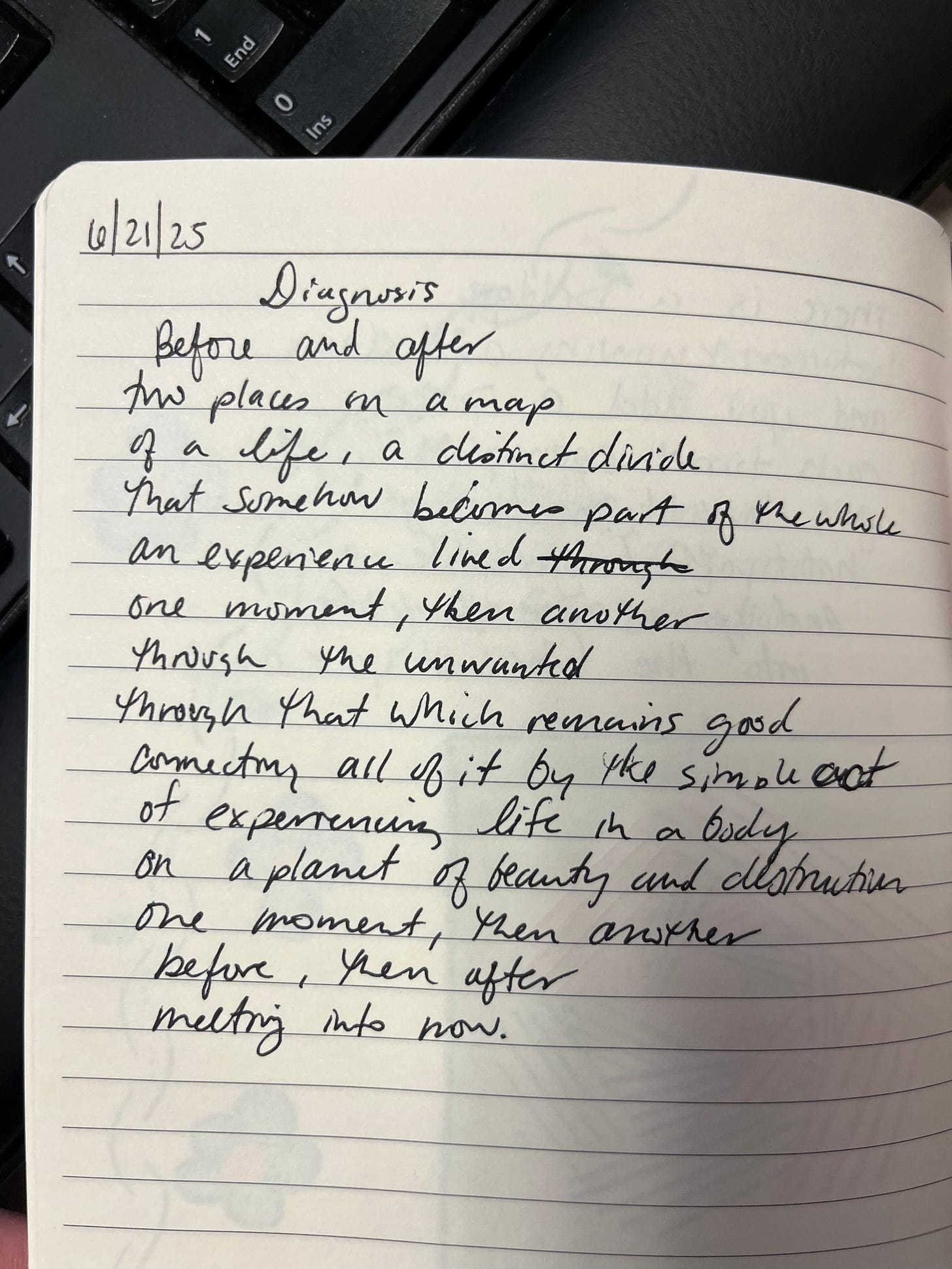In 2022, I asked my regular doctor (as an aside during an annual check up) if she thought one of the moles on my arm looked weird. She said “hmm, it’s hard to say, doesn’t look too concerning or irregular” but also, “I’m not a dermatologist, so you could have it checked out.” So I waited a few months to see if it changed, and it kept bugging me — seeing it there, peering up at me from my forearm, goading me into thinking it might be something to be concerned about. I finally got an appointment with a dermatologist, at a special dermatologist specific clinic, toward the end of that summer. The mole, when looked at the with the special device they use to look at moles and other skin lesions, was not deemed concerning enough to investigate further. They said, “You’re young enough to still develop new moles.” I left, mostly content that I’d done my due diligence and had it checked out by the experts.
Earlier this spring, when I went in for my usual annual check up, I asked my regular doctor about the mole again. It seemed to look just a little different. She was not too concerned, but mentioned there was a doctor at the clinic who had an interest in dermatology if I wanted to see them. Off I went to the rest of my day.
But it kept bugging me, especially as the weather warmed and I started wearing T- shirts that exposed my arm. I found myself wondering if it had, indeed, changed shape since I last truly had it looked at. I wondered this on enough days of the week that I scheduled another appointment at the dermatologist’s office.
Three weeks ago, I went in for the appointment and asked about the mole and another little spot that seemed unusual. The mole in question was once again deemed “not concerning.” The provider I saw this time said I could request to have it taken off and biopsied anyway if I was worried about it. I said, “Sure, let’s do that. I’d rather have a little white mark than a mole that I worry about every time I look at it.”
So she shaved it off to be sent in to the lab, explaining I’d probably get a letter a few weeks later explaining the results—that they’d only call if something was concerning, but she doubted that would be the case. Off I went to the rest of my day.
Last week, right before heading off to lead a therapeautic group at work, I looked at my phone and noticed I’d missed a call. There was a message saying I should call the dermatologist’s office at my earliest convenience. I had 15 minutes before heading to the unit where the group was to be held, so I called back. The receptionist answered, but said the provider who wanted to talk to me about results wasn’t in at the moment and “when was a good time to have her call back?”
Right. So by this time I’m a little concerned and wishing I hadn’t called right before needing to lead a group on recognizing the stress response and finding strategies to cope.1
Anyway, the group went fine, we did plenty of intentional breathing, folks named their stressors and identified some ways to cope. 90 minutes later, I was back in my office to continue being stressed as I waited for the call back.
The call came as I was pacing the indoor track, and I was informed that, “actually, even though the mole didn’t look very concerning, it is, in fact, malignant melanoma.”
Well.
I don’t remember a whole lot else about the conversation other than hearing the words “most aggressive form of skin cancer”, “superficial spreading”2 and the need to return to the office soon to hear about treatment options.

This was a lot to take in on the heels of a season that included losing a family member to an aggressive cancer, especially when we were just starting to feel like things were settling down. I’d just scribbled a the words “what do you write about when things aren’t so hard anymore?”in a journal. Ha. Well played, universe. 3
Earlier this week, when I went in to hear about treatment options and review the pathology report, the news was okay. Prognosis is good, it was caught early, and surgery to remove any melanoma cells that remain should be all that’s necessary to treat. I’ll have a decent scar and need to go in for skin checks more often, but I’ll take a scar and a few more appointments a year over the alternative.
So, folks, all this to say: watch those moles, be smart about not getting too much sun (but still get some sun!), ask about family history if that’s information available to you, and advocate for yourself if your care provider says it seems fine when you think it might not be.
Tell About It I'm thinking there's nothing new to say so why bother when a heron swoops low over glassy water wings nearly touching the surface a study in casual elegance and unapologetic being when a painted turtle marches swiftly through tall grass and wildflowers a study in unexpected urgency carving a place in time when my hand brushes strawberry leaves aside revealing blushes of red not there before a study in patience and sunlight's union when war breaks out across the world and within my own body a study in not turning away when the smoke clears skies brightening blue a study in the defiance of despair a study in beauty rising from ash in witnessing, in staying grounded enough to turn toward the peace that waits somewhere ahead even now possibility and life joining anew I'm thinking there's nothing new to say but then I remember there's plenty new to say when you pay attention in a way that allows astonishment, or maybe gratitude --some semblance or melding of gladness and grief-- to bubble up from dry ground. --after Mary Oliver
And here’s a dahlia from the garden. Because as Emerson wrote, “the earth laughs in flowers.” May we all find the levity necessary, even during the tough weeks, to buoy the spirit enough to keep on keepin’ on.
Onward.
Or maybe that was just the thing….a little practice what I preach moment.
“Superficial” is “good” when it comes to skin cancer
Mary Oliver wrote a poem called “Sometimes” that included the lines “Instructions for living a life: pay attention, be astonished, tell about it.”





